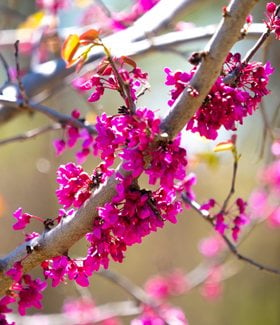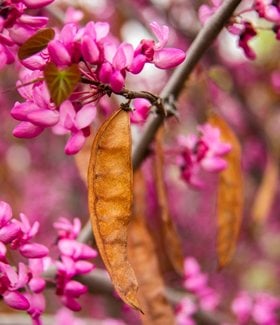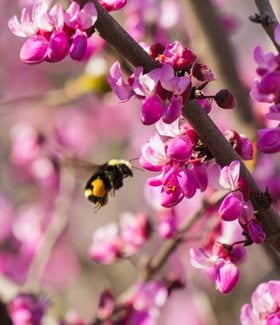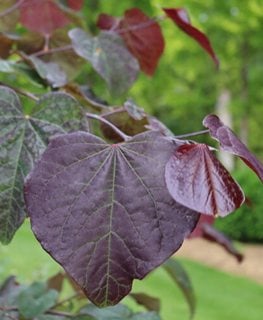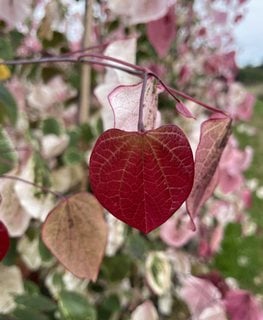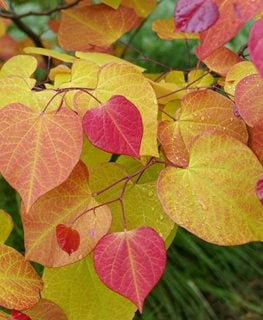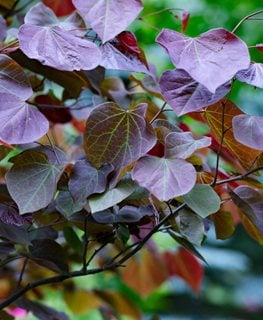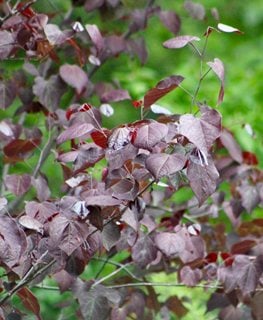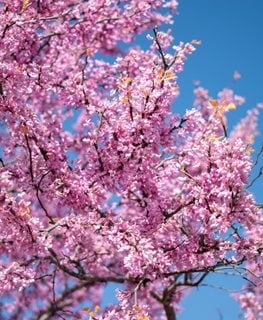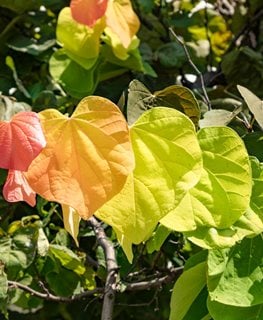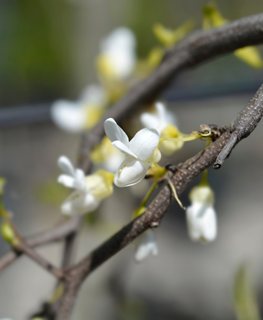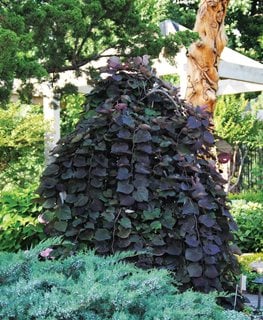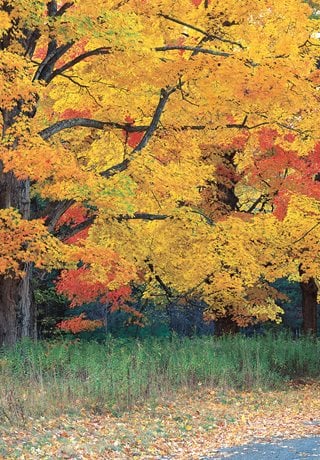How to Grow Redbud Trees: Top Varieties, Planting & Care
Add this beautiful landscape tree to your yard for multi-seasonal appealCercis spp. (redbud) are popular ornamental trees grown for the prolific clusters of pea-like flowers, attractive heart-shaped leaves, and brilliant fall color. The vase-shaped, spreading or weeping structure lends beauty and elegance to any landscape. This resilient tree is not picky about soils, and is low-maintenance once established.
Native to parts of the U.S., Asia, and the Mediterranean region, Cercis is classified in the legume family, hence the pea-shaped flowers. This versatile landscape tree can be used in a woodland setting, mixed border, native garden, as a street tree, or specimen. The pollinator-friendly flowers, which last several weeks in spring, attract a range of early season beneficial insects. Here’s how to plant, grow and use redbud tree, along with some of the best varieties for your yard.
On this page: Basics | Types | Planting | Care & Pruning | Varieties | Landscaping Ideas
On this page:
- BASICS
- TYPES OF REDBUD TREES
- PLANTING REDBUD TREES
- REDBUD TREE CARE & PRUNING
- REDBUD TREE VARIETIES
- FREQUENTLY ASKED QUESTIONS
- LANDSCAPING IDEAS
REDBUD TREE BASICS
Botanical name:
Cercis spp.
Common names:
Redbud, with common names for different species
Plant type:
Deciduous tree
Zones:
4-9
Exposure:
Full sun to partial shade
Habit:
Upright spreading, vase-shaped, shrubby or weeping habit
Size:
20 to 30 feet tall, 25 to 35 feet wide; dwarf varieties are smaller
Bloom time:
Spring
Flowers:
In early to mid-spring, prolific clusters of small pea-like flowers occur along the branches ahead of the foliage. The flowers come in various shades of white, pink, magenta, lavender, or purple. Bloom time can last 2 to 3 weeks.
Foliage:
As redbud trees finish flowering, the foliage begins to emerge. Attractive heart-shaped leaves up to 5 inches wide occur in shades of green, blue-green, burgundy, dark purple, yellow, orange, apricot, or variegated. Fall color is gold or yellow, sometimes with hints of red.
See why Laura LeBoutillier of Garden Answer loves Eastern Redbud Trees
TYPES OF REDBUD TREES
The most common species of redbud include:
Eastern Redbud (Cercis canadensis)
Zones: 4-9
Habit: Vase-shaped, weeping, or dwarf habit
Size: 20 to 30 feet tall, 25 to 35 feet wide; dwarf varieties are smaller
Color: Green foliage, pink flowers, yellow fall color. Named varieties can have chartreuse, gold, orange, bronze, burgundy, or dark purple foliage. Flowers can be pink, red, white, lavender, or magenta. Some varieties have fall color.
Popular cultivars: ‘Forest Pansy’, ‘Merlot’, ‘Golden Falls’, ‘Rising Sun’
"This species does not transplant well because it develops a deep taproot, so it is best to plant young trees." — University of Wisconsin-Madison Horticulture Extension
Western Redbud (Cercis occidentalis)
Zones: 6-9
Habit: Vase-shaped or shrubby habit
Size: 10 to 15 feet tall and wide
Color: Green foliage, rose-purple flowers, purple-brown seed pods, yellow and red fall color
Popular cultivars: 'Claremont'
"Although Cercis canadensis, the eastern redbud, and its several varieties are widely planted, they typically do not fare as well in our western gardens and show much less tolerance of our soils and dry summers than does C. occidentalis." — UC Master Gardener Program of Sonoma County, CA
Chinese Redbud (Cercis chinensis)
Zones: 6-9
Habit: Upright spreading or vase-shaped habit
Size: 8 to 15 feet tall, 6 to 12 feet wide
Color: Green foliage, rose-purple flowers
Popular cultivars: ‘Avondale’, ‘Don Egolf’
"In its native habitat, this plant acts as a woody tree that will grow up to 50 feet, however, due to differing conditions in the United States it generally grows as an open shrub that will reach 8 to 15 feet in height." — North Carolina Extension Service
Oklahoma Redbud (Cercis canadensis var. texensis)
Zones: 6-9
Habit: Upright habit with a spreading canopy
Size: 15 to 20 feet tall, 10 to 15 feet wide
Color: Green foliage, burgundy-red flowers
Popular cultivars: ‘Oklahoma’
"It differs from the straight species by having slightly more drought tolerance; darker and brighter wine red buds and flowers; glossier, thicker, broader and darker green leaves often with a more reniform (kidney-shaped) outline; leaf apices that are rounded or blunt (not pointed); and winter hardiness to USDA Zone 6 (species to Zone 4)." — Missouri Botanical Garden
PLANTING REDBUD TREES
When to plant:
The best time to plant redbud tree is in early spring after all danger of frost is past. In USDA zone 8 or higher, redbud can also be planted in fall 6 weeks before the first hard frost to allow time for roots to become established.
Where to plant:
Redbud performs best with at least 4 to 6 hours of direct sun. Flowering and foliage color will be best with more light. Choose a site at least 8 to 25 feet away from any building structure, depending on the mature size of the tree, to prevent damage to the foundation. Redbud trees do not respond well to transplanting, so make sure the site you choose is a permanent one.
Soil:
Redbud trees can tolerate a range of soil conditions, but prefer moist, well-draining soil with average fertility and a pH level between 6.5 and 8.0.
How to plant:
Loosen soil in the planting area and amend as needed to improve drainage. Dig a hole 2 to 3 times as wide as the root ball and the same depth or slightly shallower (to allow for settling) as the root ball. If planting a bare root tree, soak the roots in water for 6 to 24 hours before planting. Remove the redbud tree from its container and tease out the roots if potbound. Trim off or spread out any circling roots so they are not twisted.
Place the tree in the planting hole so the base of the trunk is level to slightly higher than the surrounding soil. Fill in the hole halfway with soil, tamp down soil gently to remove air pockets, then water thoroughly. Fill the rest of the hole with soil around the root ball, but do not cover the top of the root ball with soil. Place 3 to 4 inches of mulch around the base of the tree to help retain moisture and suppress weeds. Avoid placing mulch against the trunk.
REDBUD CARE & PRUNING
Watering:
Keep plants regularly watered during the first growing season. Water deeply to penetrate the root zone. Mature trees are drought tolerant once established and need little or no supplemental water in areas with summer rainfall. Provide supplemental water during prolonged heat and dry spells, especially if leaves show signs of wilting. Avoid overwatering to prevent root rot and other diseases.
Amendments & fertilizer:
Redbud trees need little or no supplemental fertilizer. If desired, apply a granular slow-release fertilizer in early spring that is formulated for trees and shrubs according to package instructions.
Pruning:
Allow redbud trees to retain their natural shape and size. Remove dead, diseased or damaged branches and lightly shape as needed. In late winter or early spring before flowering, lower branches can be removed to raise the canopy and reveal more of the trunk. Avoid pruning later in the growing season, as this can result in the loss of flower buds for the following year.
Diseases and pests:
Redbud trees may be susceptible to a number of pests and diseases, depending on the variety, growing conditions, and other factors. Pests may include aphids, borers, caterpillars, Japanese beetles, leafhoppers, scale, and treehoppers. Diseases include anthracnose, blights, canker, dieback, leaf spot, powdery mildew, and verticillium wilt.
Toxicity:
Redbud trees are not considered toxic to humans or pets, though ingestion of any non-edible plant may cause mild stomach upset.
REDBUD TREE VARIETIES
FREQUENTLY ASKED QUESTIONS
What is the difference between Eastern redbud and other types?
Eastern redbud is a native tree in the eastern U.S., and a common landscape tree for home gardens. There are many varieties in different shapes, sizes, and colors. Other types are less variable, or have a different native growing range.
Are redbud trees good for small gardens?
Cercis is a small- to medium-sized tree, with many dwarf and weeping varieties suited to smaller spaces. When choosing a redbud tree for your yard, make sure to allow enough room for its full mature size.
Do redbud trees attract pollinators?
Yes! This early bloomer produces spring flowers that are a rich source of pollen and nectar, attracting pollinators including bees, wasps, butterflies, moths, and other beneficial insects.
Do redbud trees have invasive roots?
Redbud trees are shallow rooted, developing an extensive root system. This is effective for erosion control, but may cause problems if planted too close to homes or other structures. Allow plenty of room for roots to spread.
What is the lifespan of a redbud tree?
The lifespan of a redbud tree is variable, depending on growing conditions, species and variety. The average is lifespan is 20 to 50 years, though some specimens may live up to 70 years.
Are redbud trees deer resistant?
Redbud trees are not favored by deer, but may have different levels of deer resistance depending on a number of factors. If other food sources are scarce in winter and early spring, deer may nibble on the tender flower buds and foliage or chew on the bark. In deer prone areas, protect redbud trees with barriers or deterrents, and surround the trees with plants that deer find distasteful. See more on protecting your garden from deer.
How fast do redbud trees grow?
Cercis have a moderate growth rate, averaging 1 to 2 feet of new growth per year, depending on the variety, growing conditions, and age of the tree.
Are redbud trees messy?
Redbud trees may be somewhat messy when dropping flowers in spring and leaves in fall. Some varieties also produce seed pods that can shed, with new seedlings that may sprout in the right growing conditions.
REDBUD LANDSCAPING TIPS
For borders and landscapes:
Use redbud tree in a mixed border, woodland garden, native landscape, mass planting, as a lawn specimen, focal point, or street tree.
For slopes and hillsides:
Redbud trees have a shallow spreading root system that is effective for controlling erosion along a slope or hillside.
For containers:
Smaller specimens can be grown in containers as long as they are given regular water and well-drained soil. Redbud trees do not transplant well, so may not survive if they are transplanted from containers into the ground.
There are many ways to use redbud trees in your landscape. Here’s how:
- Use a redbud variety with multi-seasonal appeal as a stunning focal point.
- Plant a dwarf or weeping variety in a smaller yard.
- Naturalize spring blooming bulbs and other ephemerals underneath a redbud tree for a captivating early season display.
- Add redbud to a native landscape as a focal point or shade canopy combined with plants native to your area to provide food, shelter, and nesting habitat for wildlife.
- Use a shrubby redbud variety as hedging along a property line.
- Plant a mixed border using smaller trees such as redbud and include shrubs, perennials, and ground covers for a layered effect.
- Use redbud in a woodland border as an understory tree along with other semi-shade lovers such as azalea, coral bells, hosta, and Japanese forest grass.
- Plant a large decorative container with a colorful small specimen or dwarf variety and place near a patio or deck as an attractive accent.
- Redbud is a good choice as a street tree, as the smaller size won’t grow into overhead power lines.
- Plant a redbud tree in an island lawn bed as an attractive focal point to draw attention to your home.
- Mass a shrubby variety for a colorful multi-seasonal display.
Companion plants: Choose companion plants that thrive in the same growing conditions of full sun to partial shade, moderate moisture, and average soil. Good companions for redbud trees include astilbe, azalea, bee balm, boxwood, campanula, candytuft, columbine, creeping phlox, daylily, dead nettle, elderberry, forsythia, geranium, holly, hosta, hydrangea, iris, peony, spirea, and spring-blooming bulbs.
ABOUT THE AUTHOR
Janet Loughrey is a veteran garden writer and photographer with over 25 years of experience, contributing to major publications like Garden Design, Better Homes and Gardens, and Sunset. A former Master Gardener, she brings hands-on expertise from gardening in a wide range of climates, from upstate New York to the Pacific Northwest.
RELATED:
Flowering Trees for Residential Gardens
Best Small Trees to Grow
